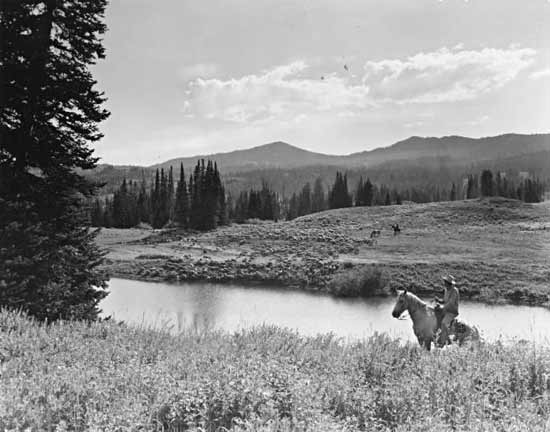Daggett County, Utah’s smallest in population, sits on the north slope of the Uinta Mountains, right up against Wyoming and Colorado. Glaciers dramatically carved the Uintas, and now they are a wilderness of cool forests, alpine meadows, lakes, and rocky peaks. 12,028-foot-tall Leidy Peak is the highest place you can stand in Daggett county.

The Green River cuts through the eastern part of the Uintas. The streams flowing from the mountains swell the Green with their waters.
Rich with trees, water, and wildlife, Clay Basin and Brown’s Hole along the Green River in northeast Daggett served as a winter refuge for both migratory animals and prehistoric Indian groups.
First Peoples
As in other areas of Utah, Paleoindian and Archaic people first came through this region more than 12,000 years ago. Around 2,000 years ago, the agricultural Fremont people settled onto the land.
Around 700 years ago, Shoshonean peoples migrated through the area, hunting at times or settling in for a season.
Explorers and Trappers
In the 1820s, fur trappers came through, finding and trapping thousands of beaver. General William Henry Ashley was perhaps the most famous of these.
After organizing a fur company in St. Louis, Ashley traveled to the Green River country in 1825 to see for himself this wildlife-rich land. He floated down the Green, through the Uinta Mountains, and into the Uinta Basin. Then he traveled by horse and foot through Summit County back to southern Wyoming, where he joined the first trappers’ rendezvous.

Other trappers and traders soon followed in Ashley’s footsteps. In 1837 Philip Thompson and William Craig built Fort Davey Crockett at Brown’s Hole. (Brown’s Hole is a rich valley on the Green River at the border of Utah and Colorado.) The fort supplied goods to the trappers in the area. A German traveler named Wislezenus described Fort Crockett as being “somewhat poverty-stricken, for which reason it is also known to the trappers by the name of Fort Misery.”
In 1869 and 1871 John Wesley Powell, a famous explorer, visited parts of Daggett County. Starting at Green River, Wyoming, Powell floated down the Green and Colorado rivers, studying the geology and geography, animal and plant life, and the Indians of the area. He named Flaming Gorge after seeing the sun reflecting off the orange-red cliffs.
The Great Diamond Hoax
About this same time rumors spread that people were finding diamonds in the Uinta Mountains in this area. Important and wealthy people in America and Europe invested in diamond mining claims, hoping to make a lot of money. But when the famous geologist Clarence King came to check it out, he found that it was all a hoax—or a scam, as we say today.
Settlers
Livestock owners used Daggett County for the summer grazing of sheep and cattle.

In the 1890s Adolph Jessen, Ellsworth Daggett, R.C. Chambers, and others introduced irrigation. This brought in farmers and their families. The first permanent settlers included the James Warby and Franklin Twitchell families.
Remote, beautiful Daggett County became Utah’s 29th and last county in 1917, when the state legislature split Uintah County.
Economy
For decades, livestock, hay, and alfalfa have been the foundation of the economy.
But the completion of Flaming Gorge Dam in 1964 brought new industries to the county: hydro-electric power and recreation. Dutch John, a town near the dam, is home to people working at the dam and on the national forest.
In the summers, Flaming Gorge Reservoir draws people who like to boat and fish.
Fast Facts
| Browns Hole, or Browns Park, attracted many kinds of people: Shoshones, trappers, traders, outlaws, and homesteaders. |
| In the 1830s, Kit Carson hunted game to supply Fort Davey Crockett on the Green River. |
| The John Jarvie Ranch gives visitors today a taste of what homesteading was like in Daggett County. |
| Cattlemen and sheepmen fought over the grazing in the area. |
| John Wesley Powell named Flaming Gorge in 1869; a dam there was built in 1962. |
Keep Exploring!
Return to the County’s home page here.
Return to the I Love Utah History home page here.